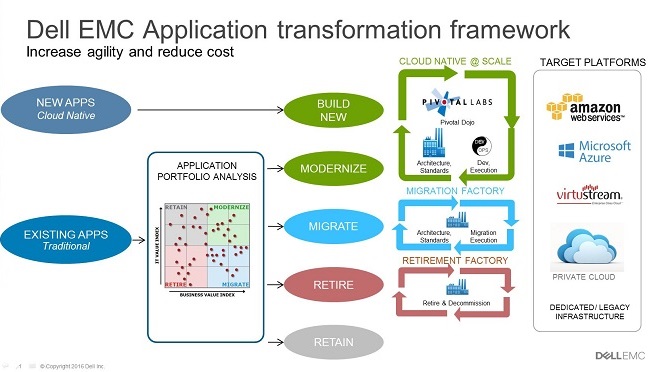‘Cloud-first’ and ‘cloud-only’ policies don’t just apply to new applications. Increasingly our clients that are driving data center modernization, migration or consolidation efforts are also applying Cloud-First principles to those efforts.
So what is a cloud-first data center transformation?
Rather starting with a bottom-up assessment of data center infrastructure, the departure point for a Cloud-First data center transformation effort is instead a top-down assessment of the legacy application portfolio. The goal? Identify which apps make sense to migrate to the public cloud, and then develop a data center strategy based on those apps that remain. In some cases this involves taking a step even further back to identify which applications should be consolidated or retired from the portfolio. Regardless of the starting point, we’re seeing an increasing number of CIOs interested in shaping their data center using an application or cloud-centric perspective.
Dell Services is working with a large medical technology company on a broad data center transformation program that provides a great example of what we’re talking about. To capture synergies from a recent major acquisition, our client is seeking to rationalize and consolidate more than 20 combined data centers. Instead of taking a ‘status quo’ mindset and just migrating apps to like infrastructure, our client wants to leverage the public cloud wherever possible as they develop their consolidation strategy. Their overall goal? Get out of the ‘data center business’ where possible.
In conjunction with the first phase of the IT transformation effort we’re helping our client with a data center consolidation effort initially focused on four major components across nearly 2,000 applications:
- Application Profiling – first we’re helping the client develop a robust application inventory across both organizations, including application dependency maps and blueprints.
- Application Rationalization – next, we’re helping our client identify what the right investment strategy is going forward for their applications based on their business and IT objectives. This includes identifying app archival and retirement candidates for unused or redundant applications, as well ‘the keepers’; applications that are candidates for public cloud migration or even Cloud Native modernization.
- Cloud Suitability Assessment – once that step is complete we’re then assessing the ‘keepers’ for suitability with public cloud environments, which for this client includes both Amazon AWS and Microsoft Azure
- Cloud Placement Analysis, Migration Bundling Analysis and Scheduling – the last step is to finalize the specific placement, target state design and architecture for the application based on is characteristics as well it’s broader app ecosystem. Move groups and scheduling will occur at this point as well.
So what happened with what’s left?
That becomes the starting point for our client’s data center consolidation efforts. The remaining applications that aren’t migrated, archived or retired become the basis for the design and build of the new, consolidated on-premises data centers.
The graphic below provides an overview of the transformation path that our client is taking. Their initial efforts are focused on identifying and migrating public cloud migration candidates out of existing data centers, while also identifying candidates for retirement, archival and decommissioning. The remaining apps are providing the foundation for identifying and sizing the right post-integration data center footprint. Note a future phase will also help them identify candidates for broader Cloud Native modernization.
Our efforts to date have already enabled the client to begin activities to close two unnecessary data centers and also provided the insight needed to begin design of a more streamlined data center footprint as well as supporting migration and modernization factories (which will discuss in more detail in future posts).
Interested in learning more about how leading enterprises are driving Cloud-First data center transformation? Contact us to learn more about how we can help.

